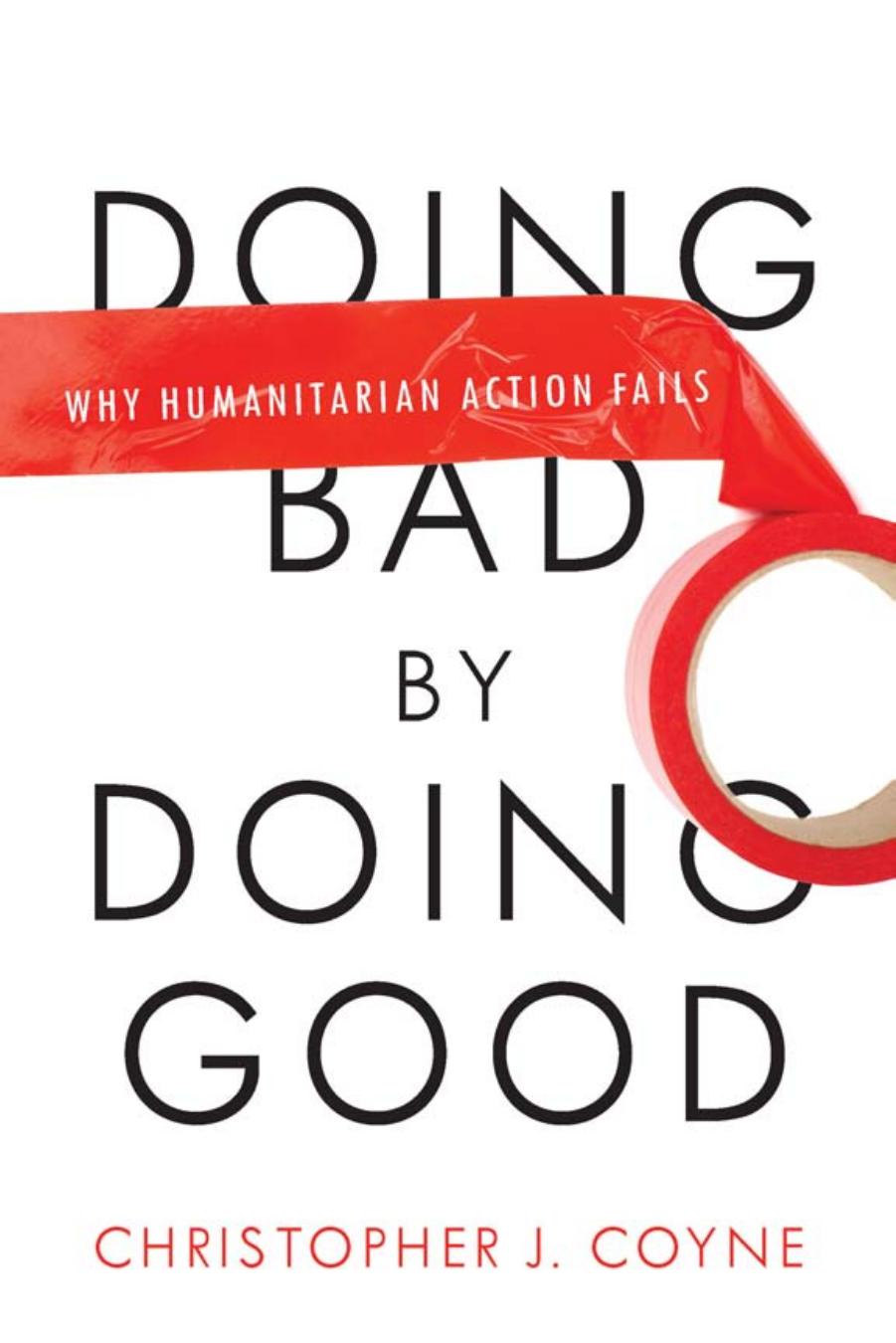Doing Bad by Doing Good: Why Humanitarian Action Fails by Christopher J. Coyne

Author:Christopher J. Coyne [Coyne, Christopher J.]
Language: eng
Format: epub, pdf
Tags: Political Science, Public Policy, Economic Policy
ISBN: 9780804786119
Google: 2HNLsqfdGjkC
Amazon: 0804772282
Publisher: Stanford University Press
Published: 2013-05-01T04:01:34.194205+00:00
CHAPTER 6
Killing People with Kindness
IN MARCH 2011, under the auspices of UN Security Council Resolution 1973, a multistate coalition began a military campaign in Libya. The intervention was in response to the Libyan Civil War, which initially had emerged from civilian protests a month earlier in the city of Benghazi. The protestors clashed with armed members of the Libyan police and military, who eventually fired on the crowd. The protest quickly spread into a nationwide rebellion leading to violent clashes between opposition forces, who organized under the National Transition Council, and forces loyal to Colonel Muammar Gaddafi, Libya’s sitting head of state. Resolution 1973 provided authorization to member states to establish and enforce a no-fly zone over Libya in order to protect citizens against attacks from Gaddafi’s forces. With the support of the coalition, which carried out air strikes against Gaddafi’s forces and key infrastructure, the opposition gained ground and, in August, secured control of Libya’s capital, Tripoli. Weeks later, the National Transition Council was officially recognized by the UN as the new, legal representative government of Libya. Gaddafi, who initially avoided capture, was eventually killed by rebel forces in October, which is the same month that the UN Security Council voted to end the mandate for military action.
Many consider the intervention in Libya to be a resounding success and a strong piece of evidence in support of the viability of the Responsibility to Protect (R2P) doctrine. During a United Nations meeting of world leaders, U.S. president Barack Obama stated that “Libya is a lesson in what the international community can achieve when we stand together as one.”1 Bennett Ramberg, who served in the Bureau of Politico-Military Affairs in the U.S. Department of State during the George H. W. Bush administration, concluded that the fall of the Gaddafi regime legitimized the R2P doctrine while putting dictators around the globe on notice.2 Stewart Patrick of the Council of Foreign Relations wrote that Libya was “the first unambiguous military enforcement of the Responsibility to Protect norm, Gaddafi’s utter defeat seemingly putting new wind in the sails of humanitarian intervention.”3
There is no doubt that the military intervention played a key role in toppling the Gaddafi regime. There is also no arguing that Gaddafi was a brutal dictator with a miserable record of not respecting the most basic rights of Libyan citizens. That said, a deeper consideration of the consequences of overthrowing the Gaddafi regime indicate that the net humanitarian gains are not as clear-cut as they may first seem by those claiming success.
The fall of Gaddafi’s government left a power vacuum in Libya that has yet to be filled. Fighting among rival militias, especially in the southern part of the country, has left hundreds dead and many more injured.4 The National Transition Council has to date been ineffective in integrating the dispersed militias that opposed Gaddafi into a single, unified national force. In addition, some of the one million African guest workers, who participated in Libya’s oil-rich economy under Gaddafi, have been violently targeted by rebels who view the migrants as Gaddafi supporters and, hence, enemies.
Download
Doing Bad by Doing Good: Why Humanitarian Action Fails by Christopher J. Coyne.pdf
This site does not store any files on its server. We only index and link to content provided by other sites. Please contact the content providers to delete copyright contents if any and email us, we'll remove relevant links or contents immediately.
The Secret History by Donna Tartt(18058)
The Social Justice Warrior Handbook by Lisa De Pasquale(11930)
Thirteen Reasons Why by Jay Asher(8399)
This Is How You Lose Her by Junot Diaz(6401)
Weapons of Math Destruction by Cathy O'Neil(5779)
Zero to One by Peter Thiel(5444)
Beartown by Fredrik Backman(5293)
The Myth of the Strong Leader by Archie Brown(5204)
The Fire Next Time by James Baldwin(4987)
How Democracies Die by Steven Levitsky & Daniel Ziblatt(4932)
Promise Me, Dad by Joe Biden(4890)
Stone's Rules by Roger Stone(4819)
100 Deadly Skills by Clint Emerson(4647)
Rise and Kill First by Ronen Bergman(4528)
A Higher Loyalty: Truth, Lies, and Leadership by James Comey(4520)
The David Icke Guide to the Global Conspiracy (and how to end it) by David Icke(4348)
Secrecy World by Jake Bernstein(4342)
The Farm by Tom Rob Smith(4294)
The Doomsday Machine by Daniel Ellsberg(4220)
